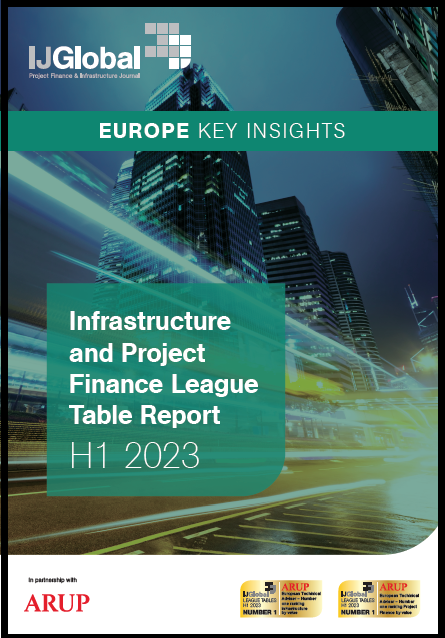IJGlobal Regional Report H1 2023 – Europe
The first half of this year (2023) was something of a mixed bag of results for Europe with the greenfield project finance of infrastructure and energy making a recovery, while refinancing activity was constrained and M&A decidedly down.
Project finance was most popular in Europe with the continent accounting for about 38% of all financial closes in the first half. The $118.1 billion recorded in Europe in H1 2023 marked a 42.3% increase from the corresponding half in 2022.
To access the Europe H1 Regional Report, CLICK HERE…
Looking across the half-year results since the start of 2019, H1 2023 considerably out-performed previous periods starting with a low point in H1 2019 at $40.2 billion, steadily – but not consistently – increasing is size up to H1 2021 which came in at $93 billion.
European greenfield PF was led by big-ticket transactions in the petrochemicals sector, followed by fibre, offshore wind and rolling stock – all of them weighing in at more than $2 billion.
The largest deal in the region to have closed in H1 – FC achieved on 23 January – was the INEOS Project ONE Ethane Cracker in Belgium. This involved the raising of €3.5 billion ($3.7bn) in debt to fund the construction and operation of Europe's first environmentally sustainable cracker. It was backed by 21 commercial banks (FC 8 March).
The second largest deal to have closed in Europe was Germany’s OXG Glasfaser Germany FttH Network with a debt package of €4.6 billion ($4.8bn) with limited recourse to Vodafone and Altice, OXG Glasfaser’s parent companies.
Fixed-foundation offshore wind farms (OWF) were always going to place among the biggest deals to have closed in the first half, and this one is the first to have fallen in Q2. The 882MW Moray West Offshore Wind Farm reached FC on 21 April with £2 billion of debt.
This deal was particularly interesting as Moray West was the first major OWF in the UK not to have the entirety of its output backed by a contract for difference (CfD). A total 294MW of the wind farm’s 882MW capacity is under the CfD scheme’s Allocation Round 4 (AR4) – awarded last year (2022) at a strike price of £37.35/MW.
The developer secured long-term corporate PPAs for a further 350MW – including a 12-year agreement with French energy company Engie and technology giant Google for 100MW. At the time of writing the case study on this OWF, the sponsor was seeking to contract out the remaining 238MW.
The 3 other biggest OWFs – all of them fixed-foundation – closed in Q2: the 496MW Dieppe-Le Treport Offshore Wind Farm in France that reached FC on 26 April with €2.5 billion of debt; Yeu-Noirmoutier Offshore Wind Farm at 496MW, again in France, which closed on 5 April with €2.2 billion of facilities; and Germany’s He Dreiht Offshore Wind Farm (960MW) with an FC date of 19 June and €1.1 billion of debt.
The offshore wind farms are interspersed at fifth place by the München S-Bahn New Rolling Stock, the €2.8 billion deal to provide 90 new public transport trains in the city of Munich, Germany. This deal was supported by the European Investment Bank (EIB) and UniCredit with €2 billion in financing to state-owned rail company Deutsche Bahn.
The most significant PPP transaction to close in Europe in the first half of 2023 was Norway’s NOK 20 billion ($25bn) E10/rv.85 motorway. This 82km DBFOM was awarded in 2 lots, the first for the NOK 11.4 billion design and construction and the second element being the NOK 1 billion O&M phase.
One of the most interesting PPP deals to close in the region – and there were not many – was the €22 million police headquarters PPP in Šiauliai, Lithuania, which closed at the very start of the year (3 January).
Request a Demo
Interested in IJGlobal? Request a demo to discuss a trial with a member of our team. Talk to the team to explore the value of our asset and transaction databases, our market-leading news, league tables and much more.


